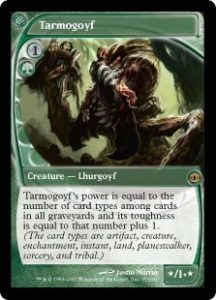Last weekend at the Team Constructed Open at SCG Philly and I had the pleasure of joining with good friends Vincent Daniels and Zac Hill. Daniels played Standard Bant Golos, while Hill played Modern Eldrazi Tron because it can be devastating against much of the field. That left me in the Legacy seat. If you read last week’s article you know I played RUG Delver.
I had a bunch of fun playing the deck, and it happens to be one of the best decks in Legacy. This week I will examine the deck in depth. RUG Delver is the premier aggro-tempo deck in Legacy: threats plus interaction. You stick a cheap threat and protect it with counterspells while disrupting your opponent and attacking them for chunks of demage until you win.
RUG Delver, by Lawrence Harmon
| Creatures (12) 4 Delver of Secrets 4 Tarmogoyf 2 Hexdrinker 2 True-Name Nemesis Planeswalkers (4) 3 Wrenn and Six 1 Oko, Thief of Crowns Spells (25) 4 Brainstorm 4 Ponder 4 Lightning Bolt 4 Daze 4 Force of Will 2 Spell Snare 1 Spell Pierce 1 Force of Negation 1 Dismember | Lands (19) 2 Scalding Tarn 2 Misty Rainforest 2 Polluted Delta 2 Flooded Strand 3 Volcanic Island 3 Tropical Island 4 Wasteland 1 Fiery Islet Sideboard (15) 1 Hydroblast 1 Pyroblast 1 Red Elemental Blast 1 Sylvan Library 1 Flusterstorm 1 Return to Nature 1 Grafdigger's Cage 2 Surgical Extraction 2 Vapor Snag 1 Submerge 1 Magmatic Sinkhole 1 Ancient Grudge 1 Force of Negation |
This was the exact 75 I ended up playing, which is 74/75 of the list from last week. Did you actually play a Magic tournament if you didn’t change a card at the last minute? The one new card compared to my old list is Oko, Thief of Crowns.
Threats
This deck is full of threats that function in different ways. Threat diversity enables RUG Delver to attack on many different angles, which makes it harder to defend against. We will go over the more common threats in the deck alongside the more hidden ones.
Tarmogoyf has always been good, but right now it happens to be better in the Legacy metagame than it has been in a while. As Legacy becomes “more fair” Tarmogoyf provides a strong and resilient threat for a tempo deck. In the mirror match, Tarmogoyf is hard to answer, and against combo decks it can win in a few turns. With the lack of Fatal Push being played in Legacy these days, the only real answers are Swords to Plowshares, Abrupt Decay, and Assassin’s Trophy. Without an answer, Tarmogoyf wins many games on its own.
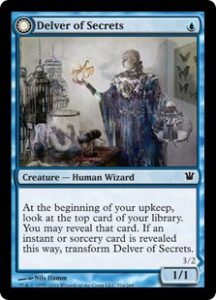
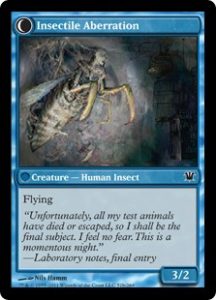
Delver of Secrets is the namesake card of the deck. The deck aims to function on one or two mana a turn, and Delver provides the most efficient threat in the deck. This lean mana requirement allows the deck to use Wasteland aggressively and enables the “free” cost of Daze. Flying is also good.
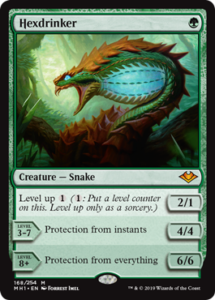
Hexdrinker provides another one-mana threat like Delver. Unfortunately, you have to spend extra mana to make it any good. Leveling at sorcery speed can expose you to removal; but once you make it a 4/4 with protection from instants, it can be back-breaking against Tundra decks and Delver variants.
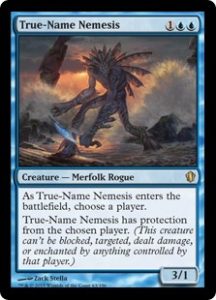
True-Name Nemesis costs three mana, so it tends to be played more in other Delver variants that use more mana. But with a more fair Legacy metagame, True-Name becomes the best threat against the fair decks, like Miracles or Jeskai Mentor decks. It also helps take over board stalls in the mirror.
Interaction
RUG Delver is a deck full of cheap or free interaction. The maindeck has 18 or more ways to interact with your opponent’s gameplan: six removal spells and twelve permission spells. A lot of them seem self explanatory, so lets go into the two that don’t.
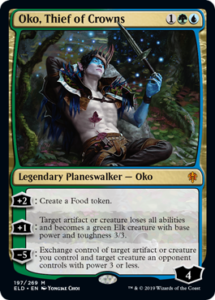
Yes, that is Standard all-star Oko, Thief of Crowns in this Legacy deck. During the trip down to Philly I got a message to put one in my deck. No context on why: just play it. So I spent the rest of the trip pondering how it would be useful in Legacy.
Oko’s +1 ability turns an artifact or creature into a 3/3 Elk with no abilities. That happens to answer both Chalice of the Void and Marit Lage. Chalice with one counter shuts down most of RUG Delver, so it is nice to have a maindeck answer to that. Marit Lage is obviously a problem in game one for any deck without Swords to Plowshares. A 3/3 Elk, not so much. RUG has Vapor Snag and Submerge to answer Marit Lage post-board, but Oko adds some chance to win game one as well.
Slow control decks also struggle against Oko as a threat in its own right. Oko acts like a slow Bitterblossom that they must answer. Make food and turn it into 3/3 elks to attack. Oko’s loyaty goes up and up, making it very difficult to answer by attacking back.
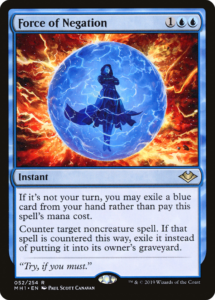
Force of Negation has been really important. A fifth free counterspell helps on the draw against Chalice of the Void and Blood Moon. Plus generally against combo decks, Delver plays as the fair deck; and you can use all the help you can get.
Going Forward
Many long time RUG players like Daryl Ayers have been crushing with four copies of Stifle. That leans heavier on the mana denial plan, as you can shut off fetchlands. Hooting Mandrills is another threat you can play, which happens to be good against True-Name Nemesis builds—the 4/4 trampler can attack into a blocking TNN and survive while dealing three damage. These changes make RUG faster and more efficient, but I still recommend the bigger version of the deck.
The sideboard can also use more help against Storm. Hydroblast was mediocre and more of a concession to Wrenn and Six decks than an answer against Storm. More copies of Flusterstorm, Grafdigger’s Cage, or another card to that effect would have been better.
Zack is a SCG grinder with one ultimate goal: getting to the Players Championship. Based out of NYC, you can find him in other cities every weekend trying to hit that goal. When he isn’t traveling he streams. Follow his journey on Twitter!


